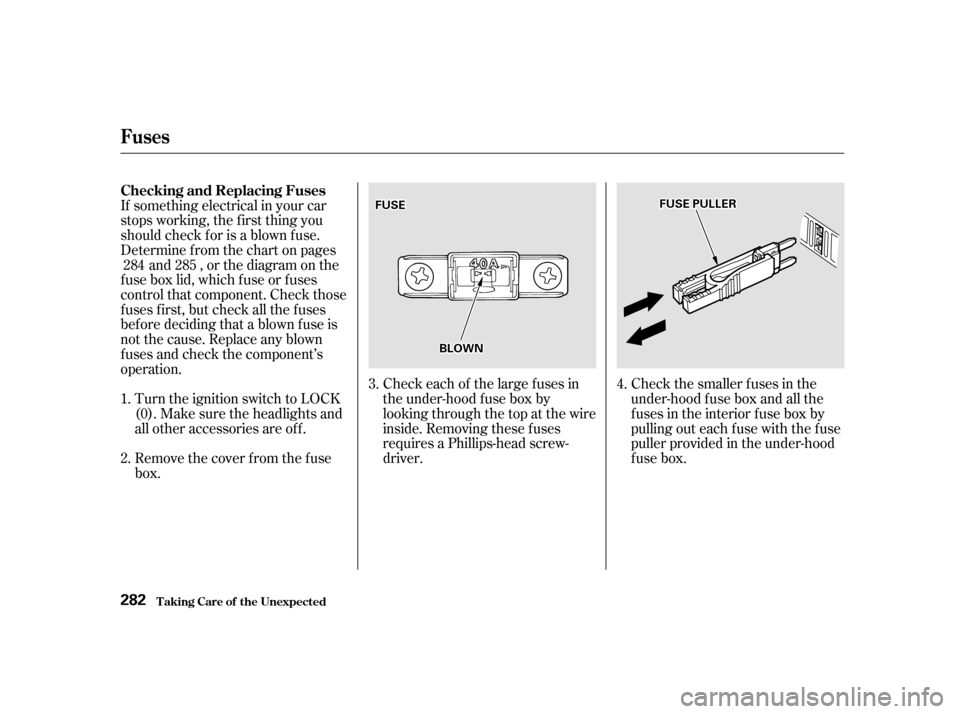Page 278 of 319

�Î�Î
�Î�ÎSlow down by shif ting to a lower
gear, and pull to the side of the road
when it is saf e. Because of the
longer distance needed to stop, it is
hazardous to drive the car. You
should have it towed, and repaired as
soon as possible. (See
on page .)
If you must drive the car a short
distance in this condition, drive
slowly and cautiously.
If it comes on at any other time, it
indicates a problem with the car’s
brake system. In most cases, the
problem is a low f luid level in the
brake f luid reservoir. Press lightly on
the brake pedal to see if it f eels
normal. If it does, check the brake
f luid level the next time you stop at a
service station (see page ). If the
fluid level is low, take the car to your
dealer and have the brake system
inspected f or leaks or worn brake
pads.
However, if the brake pedal does not
f eel normal, you should take
immediate action. Because of the
brake system’s dual-circuit design, a
problem in one part of the system
will still give you braking at two
wheels. You will f eel the brake pedal
go down much f arther bef ore the car
begins to slow down, and you will
have to press harder on the pedal.
The distance needed to stop will be
much longer.
The Brake System Indicator
normallycomesonwhenyouturn
the ignition switch ON (II). It is a
reminder to check the parking brake.
It comes on and stays lit if you do not
f ully release the parking brake.
218
286Emergency
Towing
Brake System Indicator
T aking Care of t he Unexpect ed 279
UU..SS..iinnddiiccaattoorrsshhoowwnn
BBRRAAKKEESSYYSSTTEEMMIINNDDIICCAATTOORR
Page 281 of 319

If something electrical in your car
stops working, the f irst thing you
should check f or is a blown f use.
Determine f rom the chart on pagesand , or the diagram on the
fuse box lid, which fuse or fuses
control that component. Check those
f uses f irst, but check all the f uses
bef ore deciding that a blown f use is
not the cause. Replace any blown
f uses and check the component’s
operation.
Turn the ignition switch to LOCK
(0). Make sure the headlights and
all other accessories are off.
Remove the cover f rom the f use
box. Check each of the large f uses in
the under-hood f use box by
looking through the top at the wire
inside. Removing these f uses
requires a Phillips-head screw-
driver.
Check the smaller f uses in the
under-hood f use box and all the
fuses in the interior fuse box by
pulling out each f use with the f use
puller provided in the under-hood
fuse box.
3.
1. 2. 4.
284 285
Checking and Replacing Fuses
Fuses
T aking Care of t he Unexpect ed
282
FFUUSSEE
BBLLOOWWNN
FFUUSSEEPPUULLLLEERR
Page 283 of 319
�µ �µ
�µ
Amps.
No. Circuits Protected
20 A
15 A
7.5 A 20 A
10 A
15 A
15 A
20 A
10 A
40 A
30 A
40 A
40 A
40 A
15 A
20 A
15 A
80 A
40 A
123456789
1011121314151617181920 Condenser Fan
Small Light
Interior Light
Cooling Fan
Hazard
FI ECU
Small Light
ABS F/S
Back Up
ABS Motor
Rear Defroster
Heater Motor
Power Window
Option
Lef t Headlight
Door Lock
Right Headlight
Not Used
Battery
Ignition 1
Spare Fuses
21 25
T aking Care of t he Unexpect ed
Fuses
284
UNDER-HOOD FUSE BOX
Page 284 of 319
�µ�µ �µ �µ �µ
�Î
�Î
�Î
No. Amps. Circuits Protected No. Amps. Circuits Protected
: On Canadian models
1 2345
15 A
20 A
10 A
10 A
Ignition Coil
LAF Heater
Daytime running lights
Alternator
Not Used 6789
10111213141516171819202122232425 7.5 A
20 A
7.5 A
7.5 A
7.5 A
7.5 A 10 A
10 A
15 A
15 A
7.5 A 20 A
20 A
20 A
20 A
20 A Power Window Relay
Moonroof
Accessory, Radio
Not Used
Meter
ABS
Daytime running lights
SRS
Remote Control Mirrors
Not Used
Not Used
Fuel Pump
Accessory Power Socket
Turn Lights
Front Wiper
Not Used
Front Right Power Window
Front Lef t Power Window
Rear Lef t Power Window
Rear Right Power Window
Fuses
T aking Care of t he Unexpect ed
285
INTERIOR FUSE BOX
Page 292 of 319

�µ�µ�µ
�µ�µ
�Î �Î �µ�µ �µ �µ�µ �µ �µ�µ�µ�µ�µ�µ�µ�µ �µ
�Î �Î �Î
�Î�Î
�Î�Î
�Î �Î�Î
Specif ications
T echnical Inf ormation
293
Battery Fuses
Tires
Alignment
Lights
Air Conditioning
HFC-134a (R-134a)
17.6 19.4 oz (500 550 g) SP-10
12 V
12 V 60/55 W (HB2)
21/5 W
60 psi (420 kPa , 4.2 kgf/cm
)
12 V 5 W
12 V 8 W
12 V 5 W
12 V 5 W
12 V 8 W
12 V 5 W
12 V 21 W
12 V 3 CP
12 V 21 W
12 V 21/5 W
12 V 21 W
12 V 3 CP
12 V 36 AH/5 HR
Capacity Interior
Under-hood Size
Pressure
Toe-in
Camber
Caster
1°33’45’
0°
0.00 in (0.0 mm)
30 psi (210 kPa , 2.1 kgf/cm)
T115/70D14 88M
P185/65R15 86HP185/70R14 87S
Headlights (HI/LO)
Front turn signal/side marker
lights
Front parking light
Rear turn signal lights
Stop/Taillights/Rear side
marker lights
Back-up lights
Taillights
High-mount brake light
License plate lights
Ceiling light
Front ceiling light
Spotlights
Trunk light
Refrigerant type
Charge quantity
Lubricant oil type
See page 285 or the fuse label
attached to the inside of the fuse
box door under the steering
column.
See page 284 or the fuse box
cover.
0.08 in ( 2.0 mm)
T125/70D15 95M
FrontRear
FrontRear
Front
1: EX
2: LX Front/Rear
Spare
Front/Rear
Spare
1 : U.S.: DX, LX Canada: DX, LX without ABS
2 : Canada: LX with ABS
3: EX
12
1
2, 3
1 1, 23
Page 297 of 319

�Î�Î
In Canada, Honda vehicles comply
with the Canadian Motor Vehicle
Saf ety Standards (CMVSS) f or
Emissions valid at the time they are
manuf actured.
The United States Clean Air Act
sets standards f or automobile
emissions. It also requires that
automobile manufacturers explain to
owners how their emissions controls
workandwhattodotomaintain
them. This section summarizes how
the emissions controls work.
Scheduled maintenance is on page
.
The burning of gasoline in your car’s
engine produces several byproducts.
Some of these are carbon monoxide
(CO), oxides of nitrogen (NOx) and
hydrocarbons (HC). Gasoline
evaporating from the tank also
produces hydrocarbons. Controlling
the production of NOx, CO, and HC
is important to the environment.
Under certain conditions of sunlight
and climate, NOx and HC react to
f orm photochemical ‘‘smog.’’ Carbon
monoxide does not contribute to
smog creation, but it is a poisonous
gas.
Your car has a Positive Crankcase
Ventilation System. This keeps
gasses that build up in the engine’s
crankcase from going into the
atmosphere. The Positive Crankcase
Ventilation valve routes them fromthe crankcase back to the intake
manif old. They are then drawn into
the engine and burned.
As gasoline evaporates in the f uel
tank, an evaporative emissions
control canister f illed with charcoal
adsorbs the vapor. It is stored in this
canister while the engine is of f . Af ter
the engine is started and warmed up,
the vapor is drawn into the engine
and burned during driving.
The Onboard Ref ueling Vapor
Recovery (ORVR) system captures
the f uel vapors during ref ueling. The
vapors are adsorbed in a canister
f illed with activated carbon. While
driving, the f uel vapors are drawn
into the engine and burned of f .
194
The Clean Air Act
Crankcase Emissions Control
System Evaporative Emissions Control
System
Onboard Ref ueling Vapor
Recovery
T echnical Inf ormation
Emissions Cont rols
298
Page 301 of 319
Then drive in city/suburban
traffic for at least 10 minutes.
When traf f ic conditions allow, let
the vehicle coast f or several
seconds without using the
accelerator pedal or the brake
pedal.
If the testing f acility determines the
readiness codes are still not set, see
your Honda dealer.
Select a nearby lightly traveled
major highway where you can
maintain a speed of 50 to 60 mph
(80to97km/h)foratleast20
minutes. Drive on the highway in
D (A/T) or 5th (M/T). Do not use
thecruisecontrol.Whentraffic
allows, drive f or 90 seconds
without moving the accelerator
pedal. (Vehicle speed may vary
slightly; this is okay.) If you cannot
do this f or a continuous 90
seconds because of traf f ic
conditions, drive f or at least 30
seconds, then repeat it two more
times (for a total of 90 seconds).
T echnical Inf ormation
St at e Emissions T est ing
302
Page 310 of 319

CONT INUED
...
Accessories and Modif ications . 167
................................
Accessories . 167
...
Additional Safety Precaution . 168
............................
Modif ications . 168
ACCESSORY (Ignition Key .......................................
Position) . 83
.............
Accessory Power Socket . 102
....................
Additives, Engine Oil . 206
.............................
Airbag (SRS) . 10, 48
.....................
Air Cleaner Element . 221
..............
Air Conditioning System . 106
......................
Maintenance . 230, 231
.........................................
Usage . 106
.......................
Air Outlets (Vents) . 108
.......................
Air Pressure, Tires . 234
..................
High Speed Driving . 235
.........................
Normal Driving . 235
.......................
Alcohol in Gasoline . 296
......................................
Antif reeze . 209
Anti-lock Brakes (ABS)
....................
Indicator Light . 62, 187
...................................
Operation . 185
Anti-thef t Steering Column ..............................................
Lock . 82 ..........................
Appearance Care . 253
................
Audio System . 114, 126, 138
...............
Automatic Speed Control . 76
..............
Automatic Transmission . 178
..........................
Capacity,Fluid .292
...............
Checking Fluid Level . 216
.......................................
Shif ting . 179
.
Shif t Lever Position Indicator . 178
................
Shif t Lever Positions . 179
....................
Shif t Lock Release . 182
Battery Charging System ...........................
Indicator . 62, 276
............................
Jump Starting . 270
..............................
Maintenance . 226
............................
Specif ications . 293
..............................
Bef ore Driving . 159
....................................
Belts,Seat .8,44
...........................
Beverage Holder . 101
.................................
Body Repairs . 260
Brakes
...........
Anti-lock System (ABS) . 185
.............
Break-in, New Linings . 160 ............
Bulb Replacement . 246, 247
...........................................
Fluid . 218
.........................................
Parking . 99
.................
System Indicator . 62, 279
........................
Wear Indicators . 184
.............................
Braking System . 184
........................
Break-in, New Car . 160
..
Brightness Control, Instruments . 71
........................
Brights, Headlights . 70
Bulb Replacement
..........................
Back-up Lights . 247
..............................
Brake Lights . 246
..............................
Ceiling Light . 250
................
Front Parking Lights . 244
........
Front Side Marker Lights . 244
.................................
Headlights . 243
.........
High-mount Brake Light . 247
.................
License Plate Lights . 248
.........
Rear Side Marker Lights . 246
............................
Specif ications . 293
...................................
Spotlights . 250
...............................
Trunk Light . 249
....................
Turn Signal Lights . 244
..............................
Bulbs, Halogen . 243
Index
A
B
I